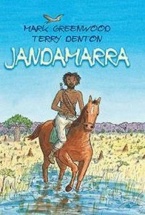Jandamarra by Mark Greenwood

Ill. by Terry Denton. Allen and Unwin, 2013. ISBN 978 1 74237 570 0.
(Age: 7+) Highly recommended. Picture book. Aboriginal themes.
Heroism. Resistance. The story of Jandamarra is one not widely
known, but should be. It is the tale of the resistance of the Bunuba
people in northern Western Australia to the incoming settlers with
their cattle and sheep. It is the obverse side of the story of
European settlement in Australia and a stark contrast to stories
such as that of the Durack family who took over a large tract in the
Kimberley and whose story is better known.
I first read of Jandamarra in a brilliant little book in a series
published by Allen and Unwin in 1997, called Kimberley Warrior.
I then watched out for references to him and his life, but could
find little. Wikipedia has a few scant paragraphs about him, and a
documentary appeared on ABC TV in 2011, and a book has been
published by Penguin and more recently Magabala Books has
republished a book about him which first appeared in 1999.
Jandamarra was at first part of the police contingent sent to the
north to keep the Bunuba people under control. He helped track and
capture Aboriginal people but became increasingly hostile to the
takeover of their land. He and others retreated to the Napier Range
near Fitzroy Crossing, where having a sound knowledge of the
surrounding countryside and the many caves in the hills, were able
to hold out against the police for several years, marauding cattle
herds passing by, evading the police and being declared an outlaw.
He was eventually found and killed, but not before he had become a
legend, a ghost who could appear and disappear at will, giving
strength to the people whose land was being occupied.
Denton's illustrations are most accessible: they portray a man the
readers will readily identify, capturing the essence of the story of
this warrior appalled by what was happening around him and taking
steps to fight. The country is brilliantly conveyed, from the harsh
outlines of the Kimberley to the Baob trees with their upside down
roots waving in the air, the bleakness of the caves from which
Jandamarra offered resistance.
The story is important from many levels: it is a story we should all
be exposed to, it is one which dispels the myth that Aboriginal
people allowed others to come and occupy their land, it shows a
proud, tough warrior fighting for his and his community's rights, a
leader still referred to today.
Fran Knight